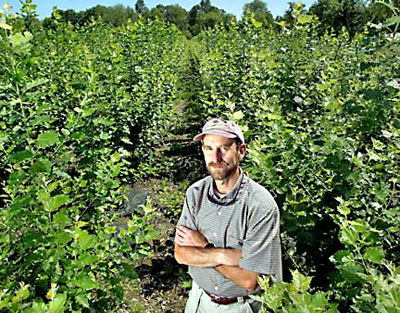|

by Paul Elias
AP Biotechnology Writer
August 01, 2003
from
ENN Website
recovered trough
WayBackMachine Website
|
Frankentrees
Are Spreading Across the U.S. |
SAN FRANCISCO
Roll over John Muir and tell Johnny
Appleseed the news:
Biotechnology is coming to the forest and
orchard.
Scientists are planting genetically engineered trees in dozens of
research projects across the country.
They are working to create
trees that grow faster, yield better wood, produce hardier crops,
fight pollution, even serve as sentinels for detecting germ and
chemical attacks.
Environmentalists fear dangerous unintended consequences.
"It won't be as widespread as agricultural biotechnology, but it
could be much more destructive," said Jim Diamond of the Sierra
Club. "Trees are what's left of our natural environment and home to
endangered species."

Oregon State
University researcher Steven Strauss
stands in a field of
genetically engineered poplar trees in Oregon.
He said there is a
lot of value in genetic engineering.
The Sierra Club wants a moratorium on the planting of genetic
engineered trees outdoors until the science is better understood.
But the plea has been like a tree falling deep in the forest.
Tree researchers say their critics are missing all the ways that
science can give nature a fighting chance against ravages natural
and manmade.
Biotechnology, they say, may provide just what is needed to help
reverse global deforestation and industrial pollution while
satisfying increased demand for wood and paper products.
Already, biotechnology has been credited with saving Hawaii's
$14-million-a-year papaya industry. A virus had wiped out 40 percent
of the crop and threatened to destroy the rest before seeds
engineered to resist the virus were introduced in 1998. Now the
industry is thriving again.
About 230 notices of genetically engineered tree experiments have
been filed with the Department of Agriculture since 1989, with about
half since 2000. So far, papayas are the only approved engineered
tree for market. The rest are still experimental.
Some researchers are infusing trees with genetic material taken from
viruses and bacteria that helps them grow faster and fatter and
yield better wood. Others are splicing mercury-gobbling bacteria
genes into trees, enlisting nature to help clean polluted soil.
Still others are inserting foreign genes that might reduce the
amount of toxic chemicals needed to process trees into paper.
Fruit-tree farmers are looking for hardier trees with less reliance
on chemical bug and weed killers.
And the Pentagon even awarded Colorado State researchers $500,000
this year to develop a pine tree or other plants that can change
colors when exposed to a germ or chemical attack.
Many field trials are backed by paper and timber companies hoping to
design trees that yield more wood and paper.
ArborGen LLC, a North Charleston, S.C.-based biotechnology company
whose backers include International Paper and MeadWestvaco Corp.,
said it has 50 field trials under way. Chief technology officer
Maud Hinchee said the company's work could reduce reliance on
national forests by creating faster-growing trees cultivated on
industry plantations.
Poplar, eucalyptus, apple and coffee trees are among those being
engineered. Researchers even hope to revive the cherished American
chestnut, devastated a century ago by a tree-stunting blight that
prevents them from growing higher than shrubs become before
succumbing.
All this is being done today because of better understanding of tree
genomes.
The Dendrome Project at the University of California at
Davis offers detailed genetic information on 100 trees on its Web
site.
Except for the Hawaiian papaya, no genetically modified tree is
expected to be commercialized for the next five to ten years. Trees
grow much slower than crops, and genetic researchers need years to
compare generations.
Could biotech trees crossbreed with their natural brethren and ruin
forests' genetic diversity? The Sierra Club fears that, among other
ecological consequences.
Researchers hope to placate critics by engineering sterility into
their designer trees, so their effect on the environment can be
contained. But that technology remains elusive.
Forestry researchers are proud of their work but have become
cautious about disclosing where their genetically engineered trees
are growing.
In June, three protesters were arrested after chaining themselves
inside a UC-Davis science building to protest tree research. And two
years ago, the Earth Liberation Front claimed responsibility for
arson attacks in Seattle and Clatskanie, Ore., that caused more than
$3.5 million in damage.
Oregon State University researcher Steven Strauss, who tends to a
few thousand engineered trees, said some of the protesters' are
virtually identical to those of scientists.
After all, he is working to engineer
poplars that are sterile.
"The violent guys just don't
understand the science," he said. "Genetic engineering is not
one thing, it's a thousand things. But the extremes want to stop
it all."
Resources
|

